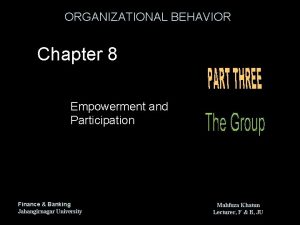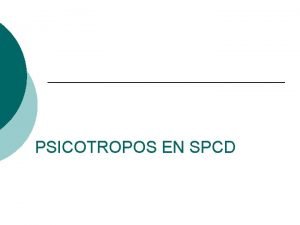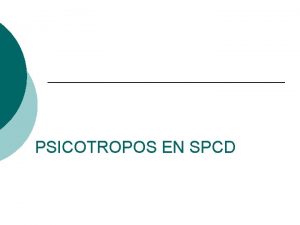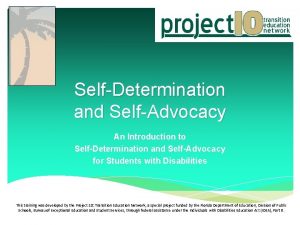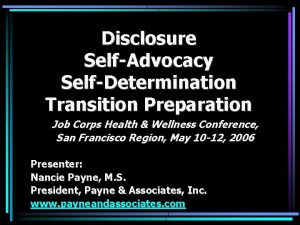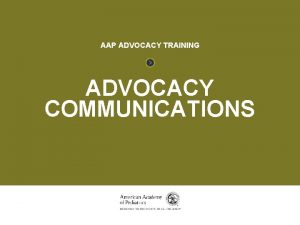Empowerment Advocacy SelfDetermination SPCD 524 Advocacy SelfAdvocacy Empowerment











- Slides: 11

Empowerment Advocacy Self-Determination SPCD 524 Advocacy & Self-Advocacy Empowerment Causal Agency Self-Determination: Initial Conceptualizations 9/2/08

Small Group Work • Work in your small groups to complete the tasks assigned. You’ll be teaching your classmates about 3 essential components of selfdetermination and helping us all begin to make the leap from theory to practice; that is, how can we as educators structure our classrooms and instruction to assist students in developing each of these component skills?

Development of the Disability Rights & Self -Advocacy Movement • Civil Rights struggle • Sweden 1960 s – Dr. Bengt Nirje, director of the Swedish Association for Persons with Mental Retardation, – Swedish Parents' Association organized conference for young adults • UK: 1972 National Conference • Canada: 1973 National Conference • People First was created: 1974 "I want to be known as a person first!"

Relevant Legislation • Rehabilitation Act of 1973 and 1992 • P. L. 94 -142 and its reauthorizations and Amendments up to IDEA 2004 • Americans with Disabilities Act (1990) • Developmental Disabilities Assistance and Bill of Rights Act and its Amendments • Olmstead vs. L. C. (1999)

Normalization Principle • Use of culturally valued means to enable people to live culturally valued lives • Use of culturally normative means to allow people lives at least as good as average citizen • Use of means that are culturally normative as possible

Implications of Normalization Principle • • A normal rhythm of day A normal routine of life Experiencing the normal rhythm of the year Opportunity to undergo normal developmental experiences of the life cycle Having ones’ choices, wishes, and desires taken into consideration and respected Living in a bisexual world Normal economic standards Same physical facility standards as those regularly applied in society to facilities for individuals without disabilities

Competency Model • Look at people first, rather than disability or label • Presume competence • Support the person’s autonomy

Inclusion • Physical inclusion • Social inclusion • Access to the general education curriculum • Participating member of ones’ community

Self-determination Acting as the primary causal agent in one’s life and making choices and decisions free from undue external influences or interference. (Wehmeyer, 1996) Self-determined behavior refers to volitional actions that enable one to act as the primary causal agent in one’s life and to maintain or improve one’s quality of life. (Wehmeyer, 2005)

Causal agency • “. . . it is the individual who makes or causes things to happen in his or her life” (Wehmeyer, p. 47 – One “who makes or causes things to happen in his or her own life” (p. 48) – To act “with intent” • Example of causal agency: http: //video. google. com/videoplay? docid =4642920755415594672&sourceid=zeitge ist

For Next Week (9/9) • Meet at NM Center for Self-Advocacy and work with your team. • Read Price et al. (2002) and Test et al. (2005) • Turn in Reflection #2
 Keynote-524
Keynote-524 Mighty minerals webquest
Mighty minerals webquest Jarak rata rata antara mars dan matahari adalah 1 524 kali
Jarak rata rata antara mars dan matahari adalah 1 524 kali Glory glory hallelujah sda hymnal
Glory glory hallelujah sda hymnal Jarak rata rata antara mars dan matahari adalah 1 524 kali
Jarak rata rata antara mars dan matahari adalah 1 524 kali The lord is my light my joy and my song
The lord is my light my joy and my song Jarak rata rata antara mars dan matahari adalah 1 524 kali
Jarak rata rata antara mars dan matahari adalah 1 524 kali Sda hymnal 524
Sda hymnal 524 Gender empowerment measure
Gender empowerment measure Empowerment and participation in organizational behavior
Empowerment and participation in organizational behavior Women empowerment points
Women empowerment points Empowerment in de zorg
Empowerment in de zorg









